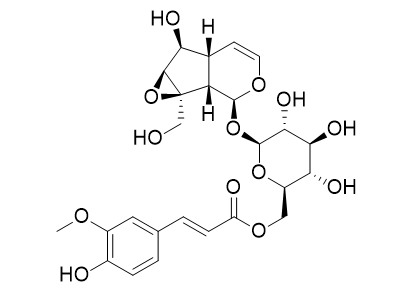Picroside III
Picrosides exhibit significant learning and memory deficits, just as Alzheimer's disease(AD) in human.
Inquire / Order:
manager@chemfaces.com
Technical Inquiries:
service@chemfaces.com
Tel:
+86-27-84237783
Fax:
+86-27-84254680
Address:
1 Building, No. 83, CheCheng Rd., Wuhan Economic and Technological Development Zone, Wuhan, Hubei 430056, PRC
Providing storage is as stated on the product vial and the vial is kept tightly sealed, the product can be stored for up to
24 months(2-8C).
Wherever possible, you should prepare and use solutions on the same day. However, if you need to make up stock solutions in advance, we recommend that you store the solution as aliquots in tightly sealed vials at -20C. Generally, these will be useable for up to two weeks. Before use, and prior to opening the vial we recommend that you allow your product to equilibrate to room temperature for at least 1 hour.
Need more advice on solubility, usage and handling? Please email to: service@chemfaces.com
The packaging of the product may have turned upside down during transportation, resulting in the natural compounds adhering to the neck or cap of the vial. take the vial out of its packaging and gently shake to let the compounds fall to the bottom of the vial. for liquid products, centrifuge at 200-500 RPM to gather the liquid at the bottom of the vial. try to avoid loss or contamination during handling.
Rep.Grant.Res.,Asahi Glass Foun.2023, No.119.
Neurotoxicology.2022, 91:218-227.
Int J Mol Sci.2020, 21(6):2190.
Food Chem.2024, 460(Pt 1):140472.
J Tradit Chin Med.2023, 43(6):1081-1091.
Nutrients.2019, 11(11):E2694
Antioxidants (Basel).2020, 9(2):E120
Chemistry of Plant Materials.2016, 33-46
Sci Rep. 2018, 10590
Int J Mol Sci.2018, 19(9):E2681
Related and Featured Products
J Pharm Biomed Anal. 2013 Jun;80:136-40.
Pipette tip solid-phase extraction and ultra-performance liquid chromatography/mass spectrometry based rapid analysis of picrosides from Picrorhiza scrophulariiflora.[Pubmed:
23567266]
Pipette tip solid-phase extraction (PT-SPE) is a technique popular in sample preparation of biological fluids and protein hydrolysates.
METHODS AND RESULTS:
In this study, we developed a microtechnic using a pipette tip packed with C18 as sorbent for extraction and purification of bioactive compounds, picroside-I, II and III, in crude herbal extracts from Picrorhiza scrophulariiflora (P. scrophulariiflora). Compared to conventional SPE, PT-SPE is fast, easy to operate, and the tools are very accessible (pipette tip and tube, without expensive SPE set-up). Moreover, it is also cost-effective because significant amount of sorbent and solvents can be saved. The eluate was analyzed by ultra-performance liquid chromatography and tandem mass spectrometry (UPLC-MS/MS). Afterwards, the method was fully validated and the results demonstrated that the PT-SPE-UPLC-MS/MS method is an excellent technique for analysis of the herbal medicine. Finally, this PT-SPE-UPLC-MS/MS strategy was successfully applied to analyze the crude extracts from P. scrophulariiflora samples within 10min (2min for PT-SPE and 8min for UPLC), 3.5mL solvents (including water, 0.3mL for PT-SPE and 3.2mL for UPLC), and 2mg C18 sorbent for each sample.
CONCLUSIONS:
We believe this method to be very practical and, in particular, to be suitable for widespread herbal medicine analysis.
J Sep Sci. 2011 Aug;34(15):1910-6.
Counter-current chromatographic method for preparative scale isolation of picrosides from traditional Chinese medicine Picrorhiza scrophulariiflora.[Pubmed:
21721121]
Apocynin, androsin, together with picroside I, picrosideII and Picroside III from crude extracts of Picrorhiza scrophulariiflora were isolated by means of high-speed counter-current chromatography (CCC) combining elution-extrusion (EE) and cycling-elution (CE) approach. The EECCC took full advantages of the liquid nature of the stationary phase for a complete sample recovery and extended the solute hydrophobicity window, while CECCC showed its unique advantage in achieving effective separation of special compounds through preventing stationary phase loss.
METHODS AND RESULTS:
In the present work, the biphasic liquid system composed of n-hexane/ethyl acetate/methanol/water (1:2:1:2, v/v/v/v) was used for separation of apocynin and androsin, ethyl acetate/n-butanol/water/formic acid (4:1:5:0.005, v/v/v/v) for picroside I,picroside II and Picroside III.However, due to the extremely similar K values (K1 /K2 ≈1.2), picroside I and Picroside III were always eluted together by several biphasic solvent systems. In this case, the CECCC exhibited great superiority and baseline separated in the sixth cycle using ethyl acetate/water (1:1, v/v) as biphasic liquid system.
CONCLUSIONS:
Each fraction was analyzed by UPLC-UV and ESI-MS analysis, and identified by comparing with the data of reference substances. Compared with classical elution, the combination of EE and CE approach exhibits strong separation efficiency and great potential to be a high-throughput separation technique in the case of complex samples.



